Abstract
STUDY OBJECTIVE: This study aimed to investigate social differences in cancer survival in residents of Turin, Italy. DESIGN: Incident cases from the Piedmont cancer registry were linked to municipality files and 1981 census data, and followed up from 1985-92. The census provided data on education and housing tenure, which were used as indicators of social class. The case fatality ratio (CFR) was estimated through a proportional hazard model, with socioeconomic indicators as risk factors. MAIN RESULTS: Educated people of both sexes showed better survival for all malignant neoplasms together and, particularly among men, for tumours which show a better prognosis such as cancer of colon-rectum, larynx, prostate, and bladder. The relative risk of dying, compared with people who had only primary school education, decreased from 0.91 for those with middle school education to 0.67 for those who held a university degree. CONCLUSION: There were major differences in cancer survival showing a poorer outcome for those from the lower social stratum, particularly in sites for which effective treatments are available. Since is unlikely that the observed differences could be totally explained by extraneous factors, such as competing mortality, it is concluded that even in a country where the health system offers universal coverage, non-financial barriers act by creating differences in opportunities for better care.
Full text
PDF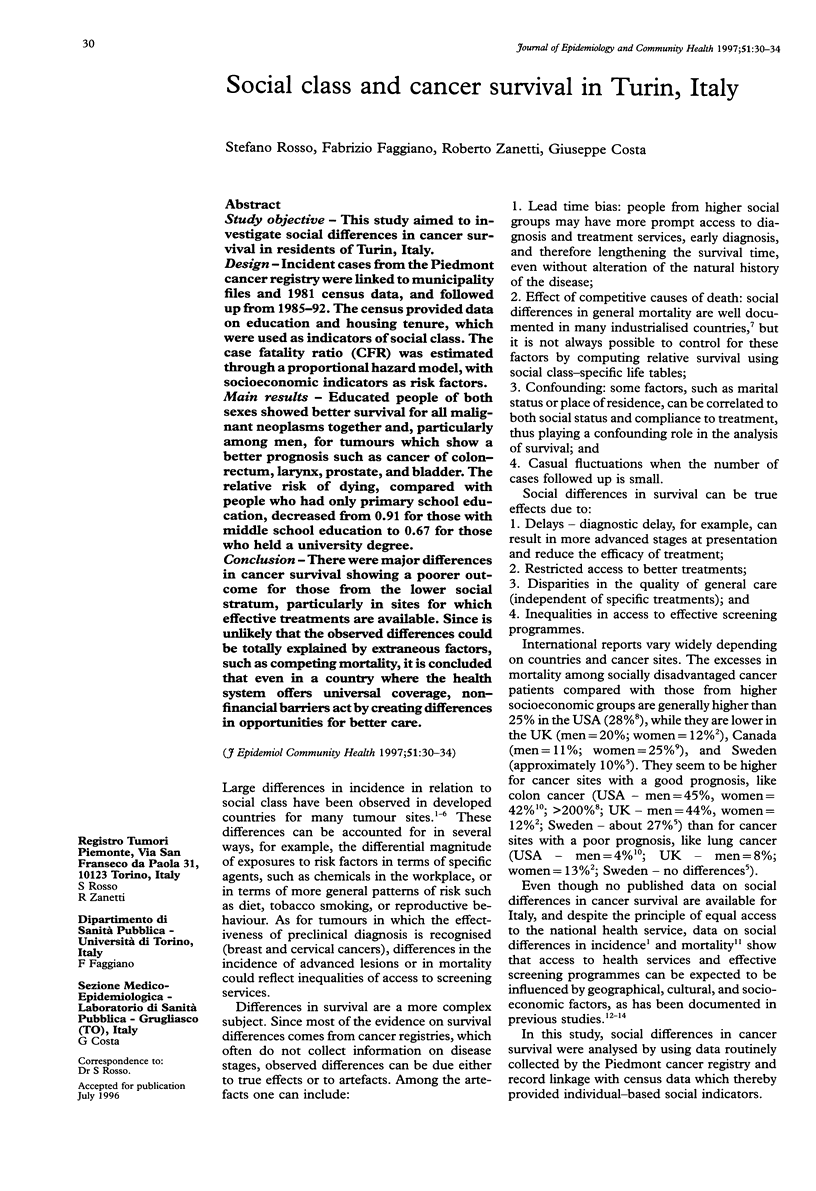
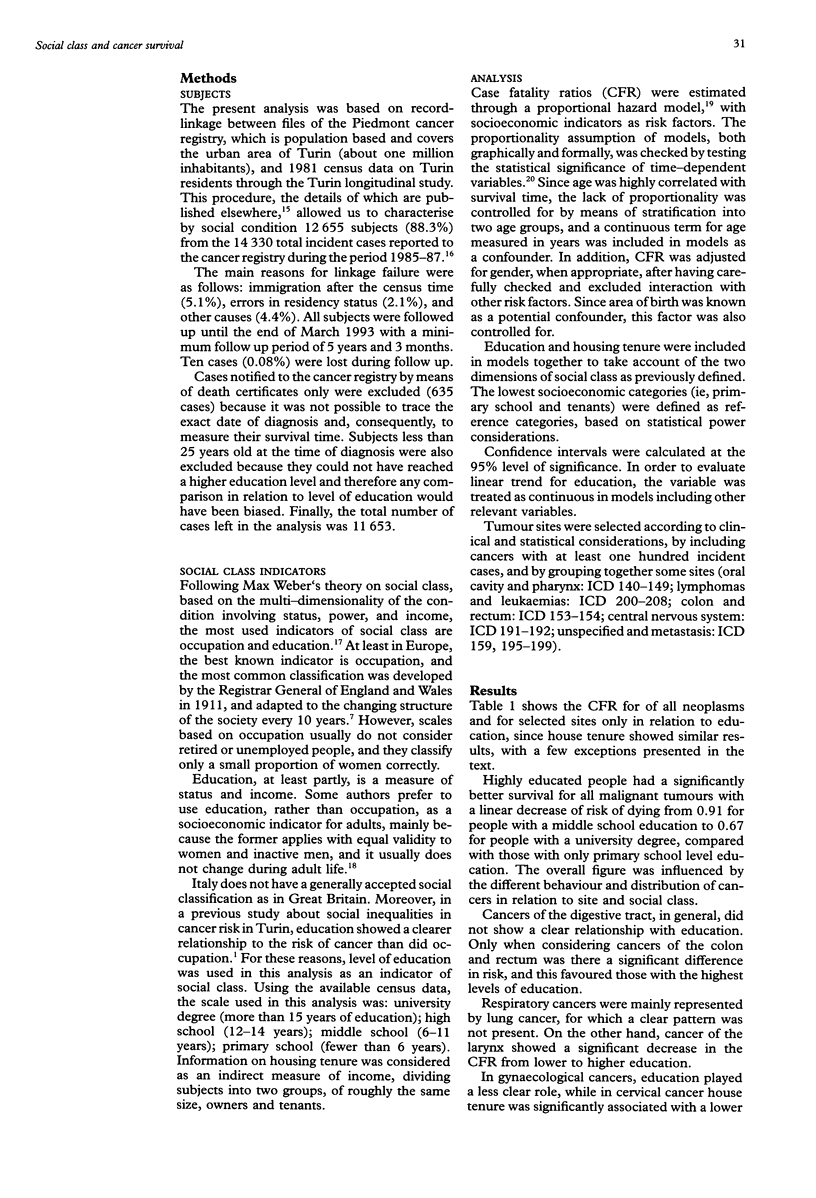
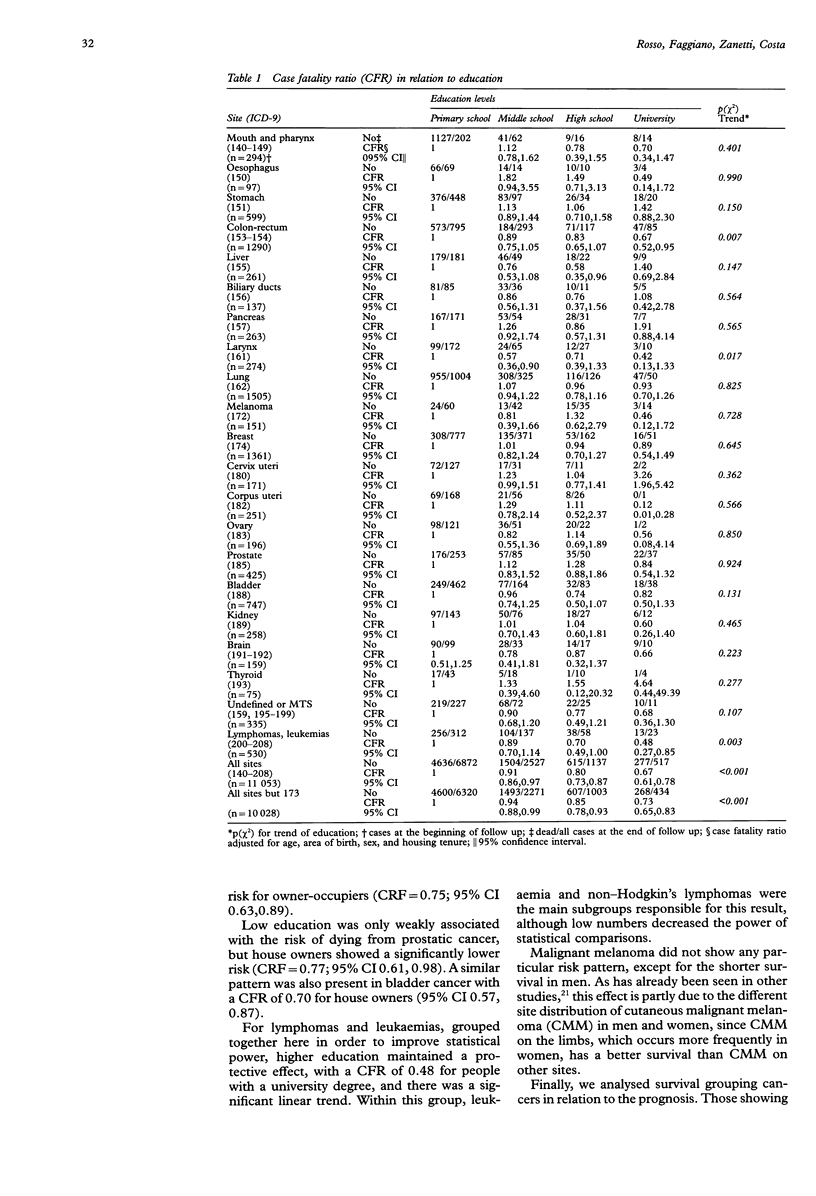
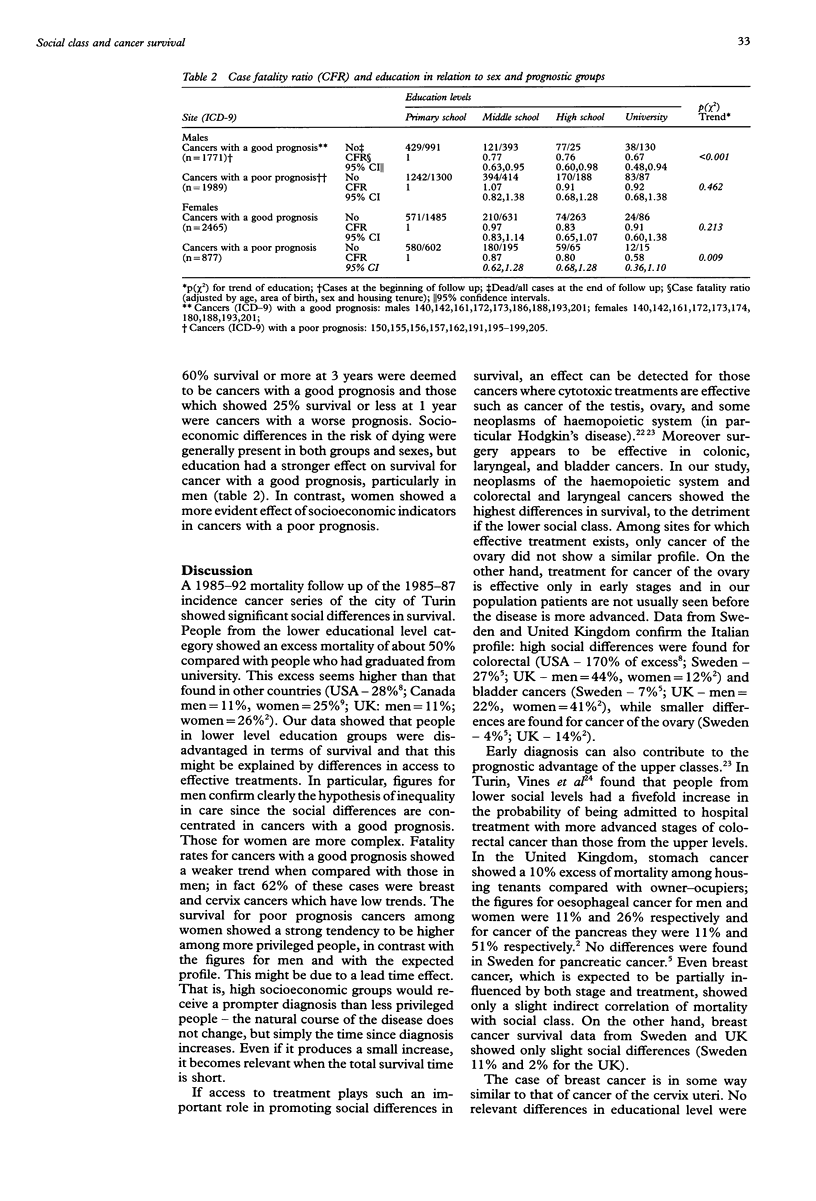
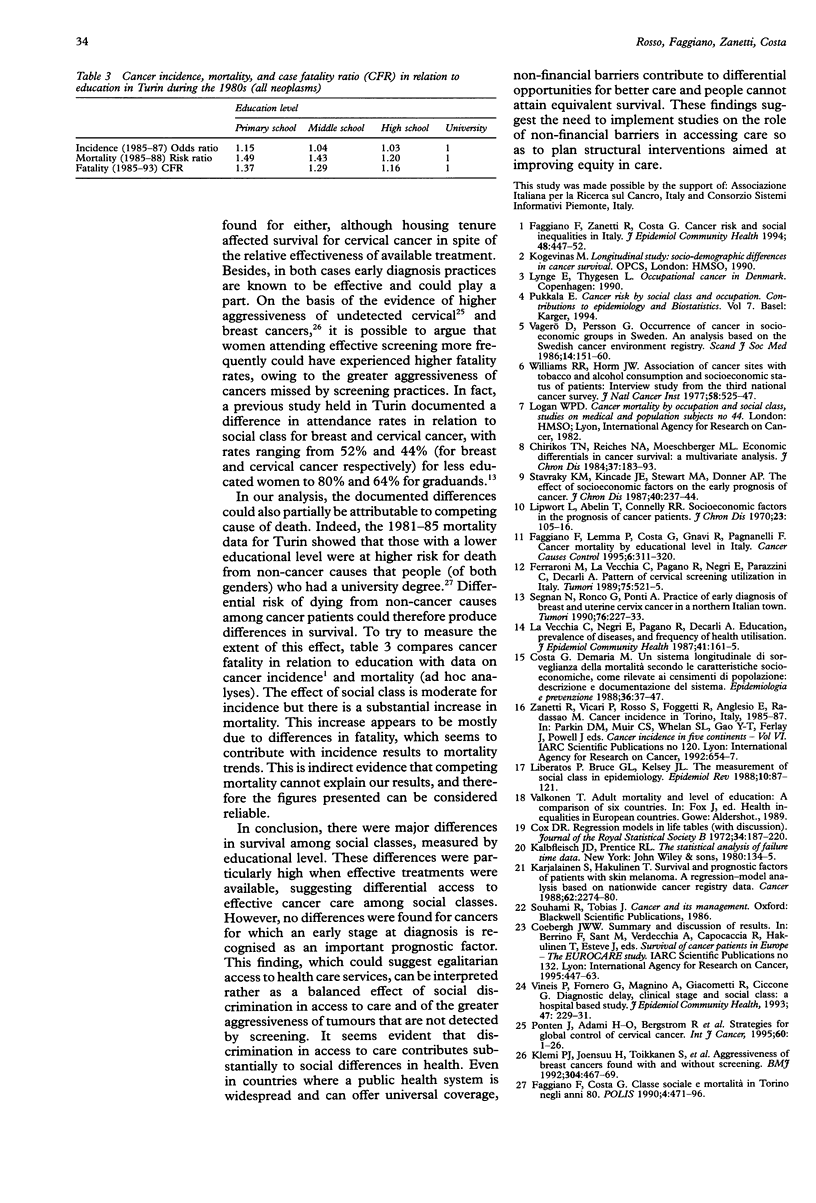
Selected References
These references are in PubMed. This may not be the complete list of references from this article.
- Chirikos T. N., Reiches N. A., Moeschberger M. L. Economic differentials in cancer survival: a multivariate analysis. J Chronic Dis. 1984;37(3):183–193. doi: 10.1016/0021-9681(84)90146-2. [DOI] [PubMed] [Google Scholar]
- Costa G., Demaria M. Un sistema longitudinale di sorveglianza della mortalità secondo le caratteristiche socio-economiche, come rilevate ai censimenti di popolazione: descrizione e documentazione del sistema. Epidemiol Prev. 1988 Sep;10(36):37–47. [PubMed] [Google Scholar]
- Faggiano F., Lemma P., Costa G., Gnavi R., Pagnanelli F. Cancer mortality by educational level in Italy. Cancer Causes Control. 1995 Jul;6(4):311–320. doi: 10.1007/BF00051406. [DOI] [PubMed] [Google Scholar]
- Faggiano F., Zanetti R., Costa G. Cancer risk and social inequalities in Italy. J Epidemiol Community Health. 1994 Oct;48(5):447–452. doi: 10.1136/jech.48.5.447. [DOI] [PMC free article] [PubMed] [Google Scholar]
- Ferraroni M., La Vecchia C., Pagano R., Negri E., Decarli A. Smoking in Italy, 1986-1987. Tumori. 1989 Dec 31;75(6):521–526. doi: 10.1177/030089168907500601. [DOI] [PubMed] [Google Scholar]
- Karjalainen S., Hakulinen T. Survival and prognostic factors of patients with skin melanoma. A regression-model analysis based on nationwide cancer registry data. Cancer. 1988 Nov 15;62(10):2274–2280. doi: 10.1002/1097-0142(19881115)62:10<2274::aid-cncr2820621034>3.0.co;2-j. [DOI] [PubMed] [Google Scholar]
- La Vecchia C., Negri E., Pagano R., Decarli A. Education, prevalence of disease, and frequency of health care utilisation. The 1983 Italian National Health Survey. J Epidemiol Community Health. 1987 Jun;41(2):161–165. doi: 10.1136/jech.41.2.161. [DOI] [PMC free article] [PubMed] [Google Scholar]
- Liberatos P., Link B. G., Kelsey J. L. The measurement of social class in epidemiology. Epidemiol Rev. 1988;10:87–121. doi: 10.1093/oxfordjournals.epirev.a036030. [DOI] [PubMed] [Google Scholar]
- Lipworth L., Abelin T., Connelly R. R. Socio-economic factors in the prognosis of cancer patients. J Chronic Dis. 1970 Aug;23(2):105–115. doi: 10.1016/0021-9681(70)90069-x. [DOI] [PubMed] [Google Scholar]
- Pontén J., Adami H. O., Bergström R., Dillner J., Friberg L. G., Gustafsson L., Miller A. B., Parkin D. M., Sparén P., Trichopoulos D. Strategies for global control of cervical cancer. Int J Cancer. 1995 Jan 3;60(1):1–26. doi: 10.1002/ijc.2910600102. [DOI] [PubMed] [Google Scholar]
- Segnan N., Ronco G., Ponti A. Practice of early diagnosis of breast and uterine cervix cancer in a northern Italian town. Tumori. 1990 Jun 30;76(3):227–233. doi: 10.1177/030089169007600304. [DOI] [PubMed] [Google Scholar]
- Stavraky K. M., Kincade J. E., Stewart M. A., Donner A. P. The effect of socioeconomic factors on the early prognosis of cancer. J Chronic Dis. 1987;40(3):237–244. doi: 10.1016/0021-9681(87)90159-7. [DOI] [PubMed] [Google Scholar]
- Vineis P., Fornero G., Magnino A., Giacometti R., Ciccone G. Diagnostic delay, clinical stage, and social class: a hospital based study. J Epidemiol Community Health. 1993 Jun;47(3):229–231. doi: 10.1136/jech.47.3.229. [DOI] [PMC free article] [PubMed] [Google Scholar]
- Vågerö D., Persson G. Occurrence of cancer in socioeconomic groups in Sweden. An analysis based on the Swedish Cancer Environment Registry. Scand J Soc Med. 1986;14(3):151–160. doi: 10.1177/140349488601400308. [DOI] [PubMed] [Google Scholar]
- Williams R. R., Horm J. W. Association of cancer sites with tobacco and alcohol consumption and socioeconomic status of patients: interview study from the Third National Cancer Survey. J Natl Cancer Inst. 1977 Mar;58(3):525–547. doi: 10.1093/jnci/58.3.525. [DOI] [PubMed] [Google Scholar]


